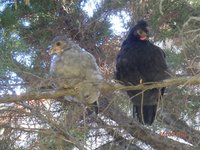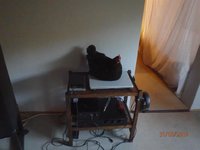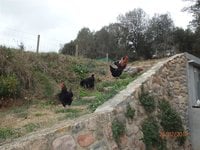I thought I would share some of the stories I've written about the Can P chickens.
Each story has some chicken 'science' in it. In this story for example one of the messages is chickens don't swim and their feathers aren't really water proof.
Another is why one shouldn't hold a chicken upside down.
A more subtle point is because chickens are so reliant on visual input wearing the same clothing and keeping your head uncovered helps the chicken match you to it's imprint.
I was going out one night, fairly unusual and had got dressed up a bit. Tribe 1 came into H Block (my house) to get out of the rain,looked at me in the strange cloths and ran straight out again.
Fat Bird's Revelations.
There was an expectant silence when I said goodnight to Tribe 1 and closed the door for the night.
Mora was perched closest to the rear door, next was Ruffles, then Fat Bird and finally Able.
Once Ruffles was satisfied I was out of earshot, she shuffled a bit closer to Mora, hopefully out of striking distance of Fat Birds beak and unable to contain her curiosity any longer, asks Fat Bird,
"How was your night with Bucket Boy then?"
Mora craned her neck out as far as she could without toppling off the perch in order to see Fat Bird past Ruffles and said,
"Come on Fat Bird, tell us what happened? Able said you fell in the pond and nearly drowned."
Able, who was busy picking mites off his bad leg hoped on to the roof of the nesting box below the perch and fearing a bit of a scrap might be in the offing, jumped up between Fat Bird and Ruffles. After some foot shuffling, squawks of indignation and a few pecks, order was restored, and Fat Bird who was now standing, said in a tone that forbade any dissent,
"I didn't fall in!"
Able pointed out he was only relaying the information he had received from Jenny the Muscovey Duck, who had told him when he went to escort Fat Bird home at bedtime, she saw Bucket Boy's sister lift Fat Bird out of the pond and carry her away.
'The Pond' is a large concrete clothes washing basin with a sloping corrugated side on which the wet clothes were scrubbed. All the chickens know the water is deep and the slope slippery. No chicken has ever 'fallen' into this basin in the past, and Fat Bird is a very experienced hen.
Chickens don't swim and avoid deep water. Their feathers are not water-proof and when their feathers are soaked, they can't fly, their body temperature drops and their body weight increases, making running much more difficult and flight impossible
"What did happen then Fat Bird?" Mora asked.
Fat Bird, looking slightly shifty, took an intense interest in rearranging her wing feathers and muttered "I can't say."
Realizing that opportunity to increase her status in telling the others the story of that night might be slipping away, Fat Bird gave one final sweeping brush of her wing with her beak and settles down on the perch, while casually mentioning that Bucket Boy takes his feather off when he goes to sleep. Ruffles and Mora's neck shot forward and their eyes widened, their attention riveted on Fat Bird.
Fat Bird mentioned in a deliberately offhand manner that while she was recovering on Bucket Boys soft rocking chair, eating the last of the tuna she had been given off the blanket that had been carefully arranged around her, she saw Bucket Boy go to bed.
Ruffles's beak dropped open and her eyes went all wistful and misty "I love tuna" she sighed, and slipped into a reverie where she attempted to recount all her favorite foods in no particular order.
"Shut up Ruffles" Fat Bird snaps, "the point is he takes his feathers off at night."
"Not sure I could fancy a man with no feathers" Ruffles murmured, still deep in her food reverie.
Fat Bird, eager to get to her most astonishing revelation, sets about telling the whole story of that night.
The others sat silent and listened, eyes wide, slightly in awe of Fat Birds experience, and slightly in awe of Fat Bird, who had after all, cheated certain death and spent the night with Bucket Boy. Fat Bird arrived at the point where she's eating the Tuna, gave Ruffles a threatening glance to forestall any further lapses in Ruffles concentration and continued her tale.
"It must have been late; easily badger time when Bucket Boy finished fussing over me and got me settled for the night. He turned out the lights except one, went to the toilet, and then into the room where his perch is. He took off all his feathers, drops them on the floor, and gets on to his perch."
Fat Bird paused and even in the gloom of the coop you could see that the memory of what happened next still haunted her. "I couldn't believe what happened next. I was close to panicking. How was I going to get out? Did anyone else known where I was? There was no more tuna; no water. I just sat there paralyzed."
Able, Ruffles and More were now on the very edge of their perches with anticipation, necks craned, eyes practically popping out of their heads and in chorus shouted,
"What happened Fat Bird?"
Fat Bird took one more pause, shuddered and said,
He said "goodnight Fat Bird," rolled onto his back and went to sleep.
Pandemonium broke out. Mora who had leaned out the furthest in order to see Fat Bird as she told her tale, slipped of her perch with a brief squawk, and crashed to the floor in an undignified pile of flying feathers and dust. Ruffles, recoiled in horror, shuffled away from Fat Bird barging Able off the perch and on to the roof of the nesting box below banging his beak on the perch during the fall as he stumbled to maintain his balance. Mora, on regaining some composure and realizing what she was about to say was bound to bring an irate Fat Bird down from above her, dived into the nesting box, and warily craning her head out, neck bent so she could see Fat Bird above said. "I don't believe you Fat Bird; everybody knows only dead things lie on their back."
Each story has some chicken 'science' in it. In this story for example one of the messages is chickens don't swim and their feathers aren't really water proof.
Another is why one shouldn't hold a chicken upside down.
A more subtle point is because chickens are so reliant on visual input wearing the same clothing and keeping your head uncovered helps the chicken match you to it's imprint.
I was going out one night, fairly unusual and had got dressed up a bit. Tribe 1 came into H Block (my house) to get out of the rain,looked at me in the strange cloths and ran straight out again.
Fat Bird's Revelations.
There was an expectant silence when I said goodnight to Tribe 1 and closed the door for the night.
Mora was perched closest to the rear door, next was Ruffles, then Fat Bird and finally Able.
Once Ruffles was satisfied I was out of earshot, she shuffled a bit closer to Mora, hopefully out of striking distance of Fat Birds beak and unable to contain her curiosity any longer, asks Fat Bird,
"How was your night with Bucket Boy then?"
Mora craned her neck out as far as she could without toppling off the perch in order to see Fat Bird past Ruffles and said,
"Come on Fat Bird, tell us what happened? Able said you fell in the pond and nearly drowned."
Able, who was busy picking mites off his bad leg hoped on to the roof of the nesting box below the perch and fearing a bit of a scrap might be in the offing, jumped up between Fat Bird and Ruffles. After some foot shuffling, squawks of indignation and a few pecks, order was restored, and Fat Bird who was now standing, said in a tone that forbade any dissent,
"I didn't fall in!"
Able pointed out he was only relaying the information he had received from Jenny the Muscovey Duck, who had told him when he went to escort Fat Bird home at bedtime, she saw Bucket Boy's sister lift Fat Bird out of the pond and carry her away.
'The Pond' is a large concrete clothes washing basin with a sloping corrugated side on which the wet clothes were scrubbed. All the chickens know the water is deep and the slope slippery. No chicken has ever 'fallen' into this basin in the past, and Fat Bird is a very experienced hen.
Chickens don't swim and avoid deep water. Their feathers are not water-proof and when their feathers are soaked, they can't fly, their body temperature drops and their body weight increases, making running much more difficult and flight impossible
"What did happen then Fat Bird?" Mora asked.
Fat Bird, looking slightly shifty, took an intense interest in rearranging her wing feathers and muttered "I can't say."
Realizing that opportunity to increase her status in telling the others the story of that night might be slipping away, Fat Bird gave one final sweeping brush of her wing with her beak and settles down on the perch, while casually mentioning that Bucket Boy takes his feather off when he goes to sleep. Ruffles and Mora's neck shot forward and their eyes widened, their attention riveted on Fat Bird.
Fat Bird mentioned in a deliberately offhand manner that while she was recovering on Bucket Boys soft rocking chair, eating the last of the tuna she had been given off the blanket that had been carefully arranged around her, she saw Bucket Boy go to bed.
Ruffles's beak dropped open and her eyes went all wistful and misty "I love tuna" she sighed, and slipped into a reverie where she attempted to recount all her favorite foods in no particular order.
"Shut up Ruffles" Fat Bird snaps, "the point is he takes his feathers off at night."
"Not sure I could fancy a man with no feathers" Ruffles murmured, still deep in her food reverie.
Fat Bird, eager to get to her most astonishing revelation, sets about telling the whole story of that night.
The others sat silent and listened, eyes wide, slightly in awe of Fat Birds experience, and slightly in awe of Fat Bird, who had after all, cheated certain death and spent the night with Bucket Boy. Fat Bird arrived at the point where she's eating the Tuna, gave Ruffles a threatening glance to forestall any further lapses in Ruffles concentration and continued her tale.
"It must have been late; easily badger time when Bucket Boy finished fussing over me and got me settled for the night. He turned out the lights except one, went to the toilet, and then into the room where his perch is. He took off all his feathers, drops them on the floor, and gets on to his perch."
Fat Bird paused and even in the gloom of the coop you could see that the memory of what happened next still haunted her. "I couldn't believe what happened next. I was close to panicking. How was I going to get out? Did anyone else known where I was? There was no more tuna; no water. I just sat there paralyzed."
Able, Ruffles and More were now on the very edge of their perches with anticipation, necks craned, eyes practically popping out of their heads and in chorus shouted,
"What happened Fat Bird?"
Fat Bird took one more pause, shuddered and said,
He said "goodnight Fat Bird," rolled onto his back and went to sleep.
Pandemonium broke out. Mora who had leaned out the furthest in order to see Fat Bird as she told her tale, slipped of her perch with a brief squawk, and crashed to the floor in an undignified pile of flying feathers and dust. Ruffles, recoiled in horror, shuffled away from Fat Bird barging Able off the perch and on to the roof of the nesting box below banging his beak on the perch during the fall as he stumbled to maintain his balance. Mora, on regaining some composure and realizing what she was about to say was bound to bring an irate Fat Bird down from above her, dived into the nesting box, and warily craning her head out, neck bent so she could see Fat Bird above said. "I don't believe you Fat Bird; everybody knows only dead things lie on their back."




















